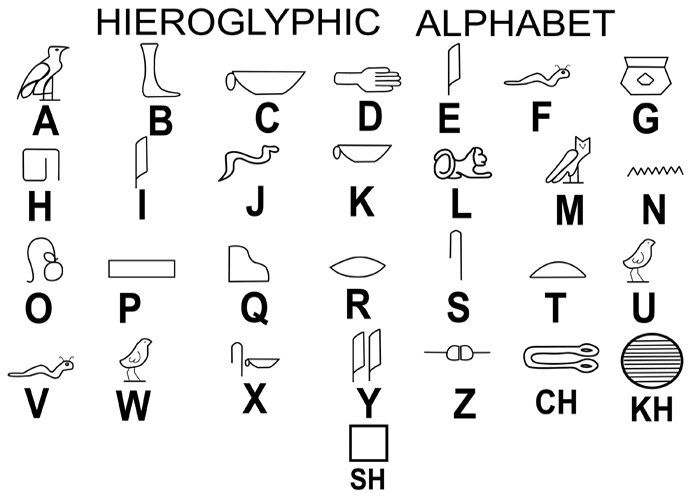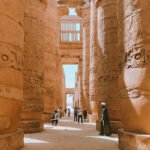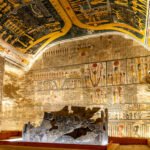The ancient Egyptian civilization is celebrated for its monumental achievements in architecture, art, and writing. Among these accomplishments, the Hieroglyphic Alphabet remains a fascinating system of writing that has captivated the interest of historians, linguists, and travelers worldwide. Unlike modern alphabets, Hieroglyphic Alphabet does not adhere to a conventional alphabetical system.
Instead, it employs a unique blend of logograms (symbols that stand for entire words), phonograms (symbols representing specific sounds), and determinatives (symbols that offer context).
Egyptian Hieroglyphs Alphabet – Hieroglyphics Alphabet A-Z
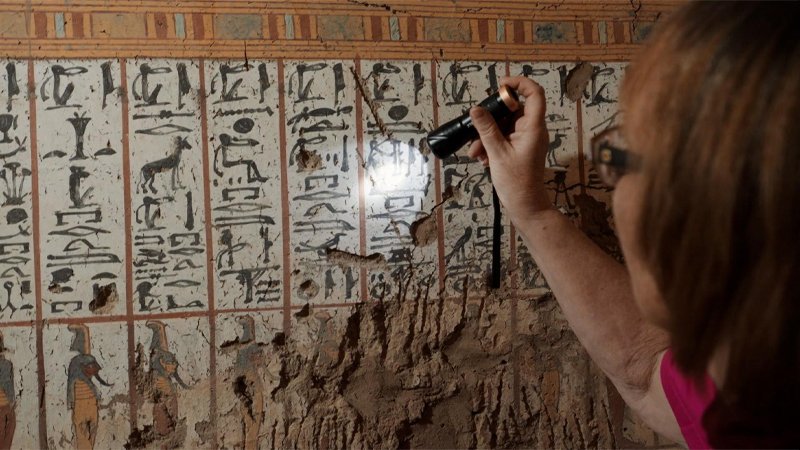
Egyptian hieroglyphs are a captivating and intricate system of writing that served as the cornerstone of written communication in ancient Egypt. Unlike contemporary alphabets, hieroglyphs blend three distinct types of symbols: logograms (which depict words or morphemes), phonograms (which denote sounds), and determinatives (which provide contextual clues to clarify meaning).
Although there isn’t a direct one-to-one correspondence between hieroglyphs and modern alphabets, understanding their unique structure offers insight into how ancient Egyptians conveyed sounds and ideas. Here’s a general overview of how hieroglyphs correspond to sounds and symbols:
1- Phonetic Hieroglyphs
These hieroglyphs function to represent sounds and, in some ways, are analogous to the letters in a modern alphabet. They are organized into three primary categories:
Consonantal Signs: Represent consonant sounds.
𓀀
(a man with a beard) – represents the sound “a”.
𓏲
(a vulture) – represents the sound “a”.
𓂋
(a mouth) – represents the sound “r”.
𓎼
(a hand) – represents the sound “d”.
𓊪
(a reed) – represents the sound “i”.
Vowel Signs: Vowels are less prominent in hieroglyphs, as ancient Egyptian writing primarily focused on consonantal sounds.
𓇋
(a reed) – represents the sound “i”.
𓄿
(a vulture) – represents the sound “a”.
Determinatives: Placed at the end of a word to provide context or clarify meaning without affecting pronunciation.
𓈖
(a seated figure) – used as a determinative for gods or important people.
𓈛
(a circle with a dot) – used as a determinative for things related to the earth.
Example of a Hieroglyphic Alphabet
Here is a simplified list of hieroglyphs and their corresponding sounds or concepts:
𓀀
“A” as in “father”
𓁹
“B” as in “bat”
𓂝
“D” as in “dog”
𓄡
“E” as in “bed”
𓆓
“F” as in “fun”
𓇠
“G” as in “go”
𓈙
“H” as in “hat”
𓇙
“I” as in “machine”
𓉐
“K” as in “kite”
𓌠
“L” as in “lamp”
𓂋
“M” as in “man”
𓄿
“N” as in “net”
𓊪
“O” as in “hot”
𓊖
“P” as in “pen”
𓋴
“Q” as in “queen”
𓎛
“R” as in “rat”
𓋾
“S” as in “sun”
𓏲
“T” as in “top”
𓋵
“U” as in “put”
𓍢
“V” as in “vase”
𓎬
“W” as in “water”
𓎼
“X” as in “box”
𓏹
“Y” as in “yes”
𓎟
– “Z” as in “zoo”
What’s an Advantage of an Alphabet over Hieroglyphics
An alphabet offers several benefits compared to hieroglyphics, such as:
- Simplicity and Ease of Learning: Alphabets typically consist of a limited number of characters (e.g., 26 letters in the English alphabet), each representing a single sound. This makes them easier to learn and use compared to hieroglyphics, which can have hundreds of symbols representing different sounds, words, or ideas.
- Speed and Efficiency: Writing with an alphabet is generally faster and more efficient. Each character corresponds to a single sound, allowing for quicker writing and reading. In contrast, hieroglyphics require more time and precision to write due to the complexity of the symbols.
- Standardization and Consistency: Alphabets provide a standardized system where each character consistently represents the same sound, making communication clearer. Hieroglyphics can vary significantly in form and meaning, leading to inconsistencies and difficulties in interpretation.
- Adaptability and Flexibility: Alphabets can be easily adapted to different languages and dialects, offering a flexible foundation for phonetic representation. Hieroglyphics, however, are more rigid and tied to specific languages and cultural contexts.
- Accessibility and Literacy: The simplicity of alphabets enhances literacy rates, making reading and writing more accessible to a broader population. In contrast, hieroglyphics were typically understood only by a small, educated elite, such as scribes and priests in ancient Egypt.
- Technological Compatibility: Alphabets are more compatible with modern technology, such as printing, typing, and digital communication. Due to their intricate designs, hieroglyphics are less suited for these applications, making them harder to incorporate into contemporary systems.
These advantages have contributed to the widespread adoption of alphabetic writing systems throughout history, facilitating communication, education, and the dissemination of knowledge across cultures and generations.
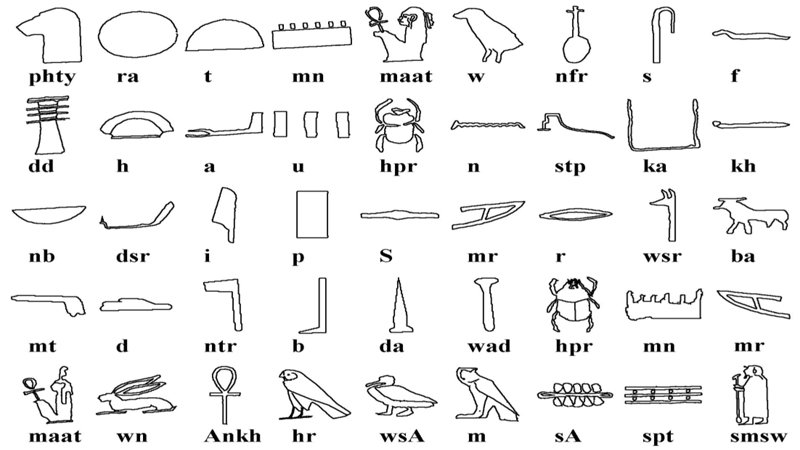
The Origins of Hieroglyphs
he origins of the hieroglyphic alphabet trace back to around 3100 BCE, coinciding with the unification of Upper and Lower Egypt. This writing system evolved from earlier proto-writing forms used primarily for record-keeping and administration.
Initially, hieroglyphs were employed to inscribe royal monuments, religious texts, and administrative documents. The term “hieroglyph” itself derives from the Greek words “hieros” (meaning sacred) and “glyphein” (meaning to carve), highlighting the script’s significant role in sacred and monumental contexts.
Over time, the script developed into a complex system that incorporated logograms (symbols representing whole words), phonograms (symbols representing sounds), and determinatives (symbols that indicate word categories). This evolution allowed hieroglyphs to convey a rich array of meanings and nuances, making them a powerful tool for communication in ancient Egyptian society.
Structure and Components of the Hieroglyphic Alphabet
The hieroglyphic alphabet consists of three primary types of signs: logograms, phonograms, and determinatives. Logograms symbolize entire words or morphemes, represented by symbols like those for “sun” or “water.” Phonograms signify sounds or syllables, enabling the formation of words through phonetic spelling.
Determinatives lack phonetic value but serve to clarify a word’s meaning, helping to differentiate between homophones. This multi-faceted approach rendered hieroglyphic writing remarkably versatile, adept at conveying complex ideas and narratives with great precision.
Deciphering Hieroglyphs -The Rosetta Stone
For centuries, the mystery of the hieroglyphic alphabet puzzled scholars until the discovery of the Rosetta Stone in 1799. This stele, inscribed with a decree in three scripts—hieroglyphic, Demotic, and Greek—provided the key to unlocking the language.
In 1822, French scholar Jean-François Champollion made the breakthrough by deciphering the phonetic components of hieroglyphs and translating their meanings. The discovery of the Rosetta Stone and its subsequent decipherment marked a turning point in Egyptology, allowing historians to read and understand ancient Egyptian texts with unprecedented accuracy.
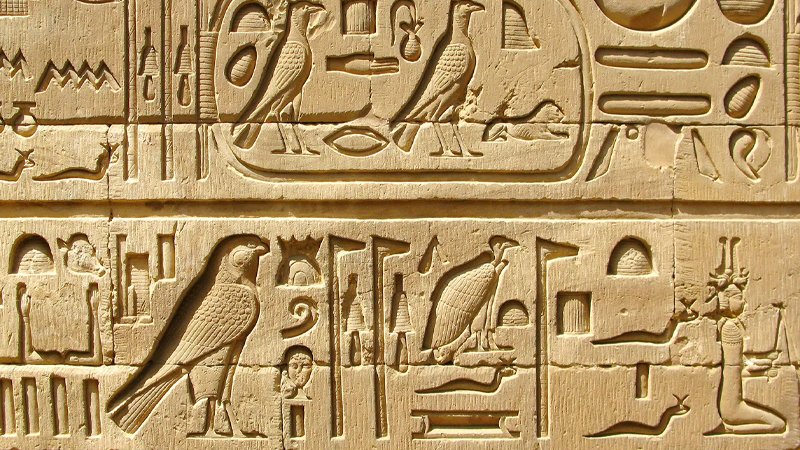
Hieroglyphs in Daily Life and Religion
Hieroglyphs permeated every aspect of ancient Egyptian life, encompassing administrative records, monumental inscriptions, religious texts, and personal letters. Temples and tombs were adorned with hieroglyphic prayers, hymns, and spells created to honor the gods and ensure safe passage to the afterlife.
Hieroglyphs were employed in administrative documents to record taxes, trade transactions, and legal matters. Even personal correspondence and literary works were composed in this script, highlighting its essential role in both public and private life.
Artistic and Symbolic Significance of Hieroglyphs
Beyond their practical uses, hieroglyphs possessed profound artistic and symbolic significance. The aesthetic beauty of hieroglyphic inscriptions enhanced the grandeur of Egyptian monuments, with each symbol carefully carved and often painted in vivid colors.
The script’s pictorial nature also imbued it with symbolic meanings, where specific symbols represented divine concepts, cosmic elements, or moral virtues. For instance, the ankh symbolized life, while the scarab beetle denoted rebirth and regeneration. This fusion of art and language elevated hieroglyphs to a revered status within Egyptian culture.
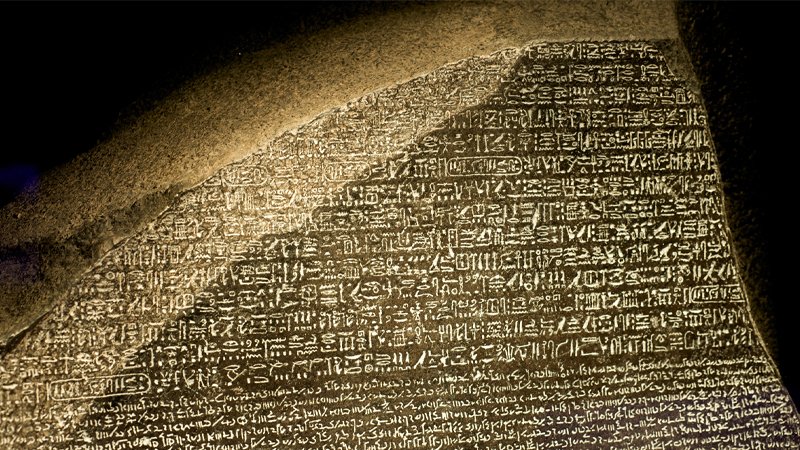
Hieroglyphs and the Afterlife
The ancient Egyptians’ belief in the afterlife profoundly shaped their use of hieroglyphs. Tombs and funerary texts were inscribed with hieroglyphic spells and invocations to guide the deceased through the perilous journey to the afterlife.
The “Book of the Dead,” a compilation of spells and instructions, was frequently buried with the dead to ensure their protection and successful rebirth. Hieroglyphic inscriptions on tomb walls and sarcophagi illustrated scenes of the afterlife, including the weighing of the heart ceremony, where the deceased’s soul was judged by the gods. These texts and images provided comfort and assurance of eternal life to the ancient Egyptians.
Learning to Read and Write Hieroglyphs
Becoming a scribe in ancient Egypt necessitated rigorous training and a comprehensive understanding of the hieroglyphic alphabet. Scribes, who were esteemed members of society, learned to read and write through years of education in temple schools.
They perfected the use of reed brushes and ink on papyrus, in addition to the carving of hieroglyphs on stone. The profession of scribe was often hereditary, passed down through generations. Scribes played a vital role in maintaining the administrative, religious, and cultural functions of the state, recording everything from royal decrees to literary compositions.
Hieroglyphs in Modern Egyptology
The study of hieroglyphs remains a cornerstone of modern Egyptology. Scholars continue to uncover new texts and inscriptions, illuminating previously unknown facets of ancient Egyptian civilization. Advances in technology, such as digital imaging and 3D modeling, have transformed the documentation and analysis of hieroglyphic inscriptions.
These innovations enable researchers to preserve and examine fragile artifacts without causing damage. The ongoing decipherment and interpretation of hieroglyphic texts contribute significantly to our understanding of Egypt’s history, religion, and society.
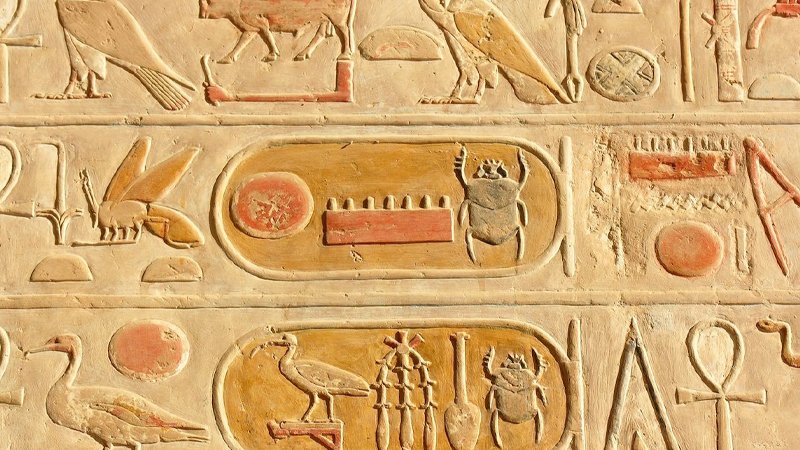
Hieroglyphs and Tourism in Egypt
For travelers to Egypt, the hieroglyphic alphabet adds a layer of depth and fascination to their explorations. Visiting iconic sites like the temples of Karnak and Luxor, the tombs in the Valley of the Kings, and the pyramids of Giza, tourists can marvel at the intricate hieroglyphic inscriptions that narrate the stories of pharaohs and gods.
Many tour guides and educational programs provide insights into reading and interpreting hieroglyphs, enriching the travel experience. Souvenirs and educational materials featuring hieroglyphic symbols are popular among visitors, offering a tangible connection to Egypt’s ancient heritage.
The Legacy of Hieroglyphs
The legacy of the hieroglyphic alphabet extends beyond its historical and cultural significance. It has inspired contemporary art, literature, and design, symbolizing the enduring allure of ancient Egypt. Hieroglyphs have appeared in modern films, books, and video games, captivating audiences with their mystique and beauty.
Educational programs and workshops on hieroglyphic writing continue to engage students and enthusiasts worldwide, fostering an appreciation for this ancient script. The hieroglyphic alphabet remains a testament to the ingenuity and creativity of the ancient Egyptians, whose legacy continues to inspire and captivate people around the globe.
Hieroglyphic Alphabet PDF
Conclusion
The hieroglyphic alphabet is more than just a writing system; it serves as a window into the soul of ancient Egypt. Through its intricate symbols and profound meanings, hieroglyphs unveil the beliefs, aspirations, and daily life of a civilization that has fascinated the world for millennia.
For travelers to Egypt, understanding the hieroglyphic alphabet enriches their experience, allowing them to connect with the past in a deeply meaningful way. As we continue to study and celebrate this remarkable script, the hieroglyphic alphabet remains a bridge between the ancient and modern worlds, illuminating the timeless legacy of Egypt’s pharaohs and their people.


